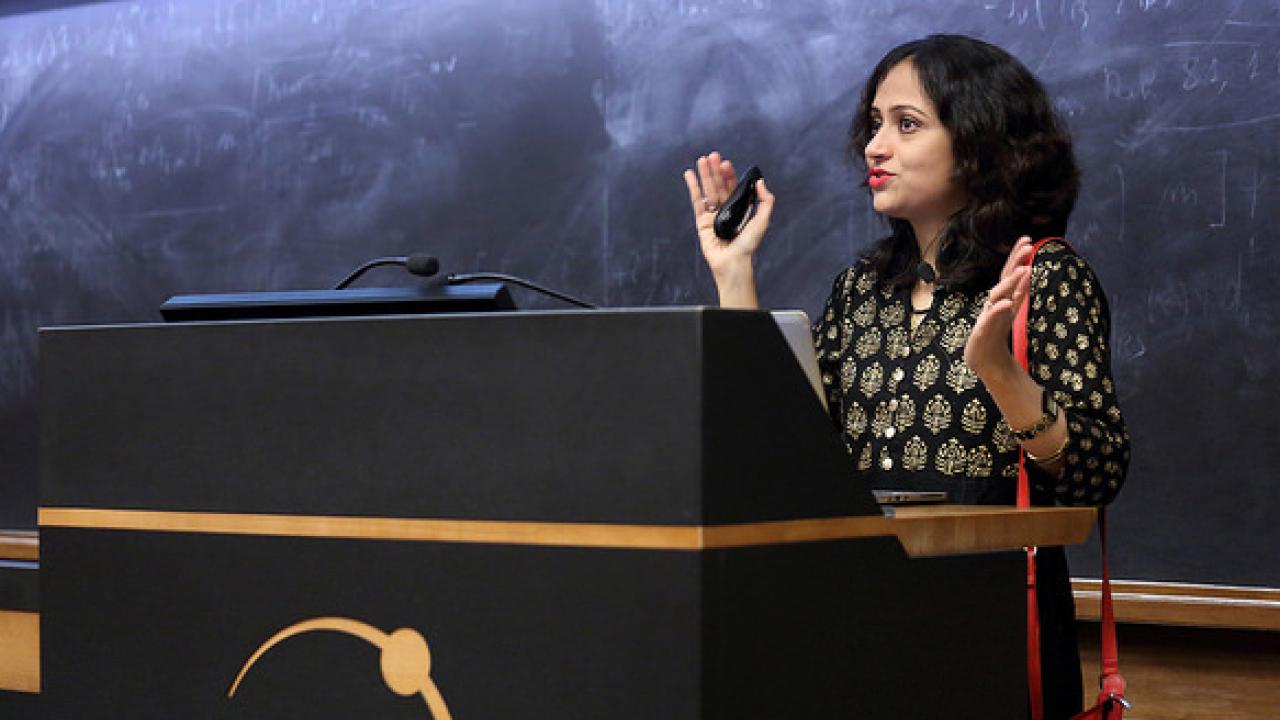
In India, she created and leads the country's first laboratory dedicated to research in quantum optics, directing ground-breaking research in quantum information and computing. Her research achievements, combined with her active promotion of optics research to the general public, have earned Urbasi Sinha the 2018 International Commission for Optics(ICO)/ICTP Gallieno Denardo Award.
The optics prize is awarded annually to researchers younger than 40 years of age from a developing country who have made significant contributions to the field of optics or photonics. Sinha was presented with the award at a ceremony held at ICTP on 13 February, during the Centre's annual Winter College on Optics. Photos from the ceremony are available here, and a video recording of the ceremony as well as Sinha's prize lecture is here.
At her Quantum Optics Laboratory based at the Raman Research Institute in Bengaluru, India, Sinha has been investigating new frontiers in the world of quantum optics. Her experience in the field prepared her well for the pioneering role she now finds herself in. Educated at Cambridge, she spent several years at Canada's Institute for Quantum Computing (IQC), where she was encouraged by IQC Founder and Director Raymond Laflamme (a student of Stephen Hawking) to perform experiments in IQC's quantum optics lab. "I wanted to learn quantum optics by experimentation, and this was one of the best environments to do that in," Sinha explained. One of her first experiments there was to test a key concept of quantum mechanics known as Born's rule ( a rule that predicts the probabilities for occurrence of events) but had, until then, never been explicitly tested. The results of that experiment, summarized in an article with Sinha as lead author and Laflamme and others as co-authors, proved the validity of Born's Rule and received broad media coverage after it was published in Science magazine in 2010 (10.1126/science.1190545).
Back in India, Sinha's lab is pursuing several research lines, providing valuable hands-on experience to the many students who are keen to work with a scientist of Sinha's international stature. "Quantum information is a very new area in India , especially experimental, and ours is one of the first modern labs to be dedicated to this field," she said. One activity at the lab is investigating a higher dimensional system--a unit of quantum information--called a qutrit. "This is an alternative approach to trying to increase the number of qubits in a quantum computer, which is what most people are trying to do," Sinha explained, referring to technology giants like IBM and Intel who are in a race to produce quantum computers with 50 qubits.
Qubits are the quantum version of the classical transistors found in today's computers where transistors perform calculations using one of two values--0 or 1; qubits can be both values at once. Sinha explained, "This is called a superposition state, and is what forms the basis for the exponential speed-up of a quantum computer, because instead of having access to only two states you have access to, in principle, an infinite dimensional space."
Sinha's lab is investigating a potentially more powerful system , called a qutrit. "We have developed a very innovative system which is using the spatial degrees of freedom of a single photon," she said, pointing out that the more conventional approach is to use a photon's polarization degree of freedom, which makes it have only two dimensions. "By using the spatial degree, I can increase the dimensionality of the Hilbert space to, in principle, as much as I like by using a smaller number of systems. That is the basis for the potential advantage of these higher dimensional systems."
Quantum computing is just one of many investigations taking place at Sinha's lab; other research lines include quantum entanglement and quantum key distribution. The latter, explained Sinha, will play an important role in information security once quantum computers become a reality. "The problem is that a quantum computer is going to be able to run an algorithm which can break the classical key distribution, called Shor's Algorithm, that is used for encryption and decryption. So, we need a quantum answer to the question."
To that end, Sinha's lab has been chosen to represent India, through the Indian Space Research Organization, in an international collaboration with Canada to explore satellite-based experiments using long strings of entangled photons that could lead to the discovery of hack-proof communications. Sent through the near-vacuum of space, entangled photons containing quantum keys would be at less risk of degrading than if they travelled through the air or via optical fibers. "This project is rewarding, because thanks to all of the effort we have done over the past several years in the lab, we have been recognized to represent India on a forum," said Sinha.
Clearly a forward-looking thinker, Sinha remains touched by echoes of the past. One of her most treasured memories is the thank you note she received from Gustav Born, the son of Nobel Laureate Max Born, after she published the Science article that validated Born's Rule. "He wrote how thankful he was that we had performed the first experimental confirmation of the Born rule. He talked about how close he was to his dad, in a way that it was just another person, but it was Max Born! The letter is displayed on a wall in my office, as an inspiration. Since then I have been working in all areas of optics and photonics, because it is fascinating!"
















